Some birds follow moving swarms of army ants in the tropics. As the ants march along the forest floor hunting insects and small vertebrates, birds follow and pick off any insects or small vertebrates that fly or jump out of the way of the ants. This situation is an example of what kind of species interaction between the birds and the ants?
A) consumption B) commensalism C) parasitism D) mutualism
Answer: B
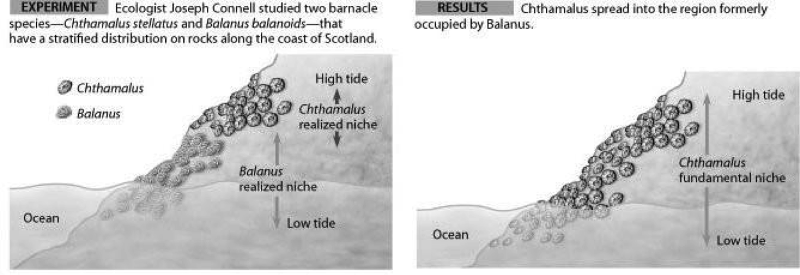
Use the figures to answer the following question.
In the hypothesis that Chthamalus stellatus (a species of barnacle) is competitively excluded from the lower intertidal zone by Balanus balanoides (another species of barnacle), what could be concluded about the two species?
A) The fundamental and realized niches of B. balanoides and C. stellatus are identical.
B) The fundamental and realized niches of B. balanoides and C. stellatus are different.
C) The fundamental and realized niches of B. balanoides are different, but the fundamental and realized niches of C. stellatus are identical.
D) The fundamental and realized niches of B. balanoides are identical, but the fundamental and realized niches of C. stellatus are different.
Answer: D
What conclusion can you draw from the figure?
A) Without direct contact, mussels can sense the presence of crabs.
B) Mussels can sense the presence of crabs only visually.
C) Mussels are increasing their shell thickness in response to water current.
D) Crabs hunt for mussels by focusing on the chemicals they emit into the water.
Answer: A
As you study two closely related predatory insect species, the two-spot and the three-spot avenger beetles, you notice that each species seeks prey at dawn in areas without the other species. However, where their ranges overlap, the two-spot avenger beetle hunts at night and the three-spot hunts in the morning. When you bring them into the laboratory and isolate the two different species, you discover that the offspring of both species are found to be nocturnal. You have discovered an example of ________.
A) mutualism
B) character displacement
C) Batesian mimicry
D) resource partitioning
Answer: D
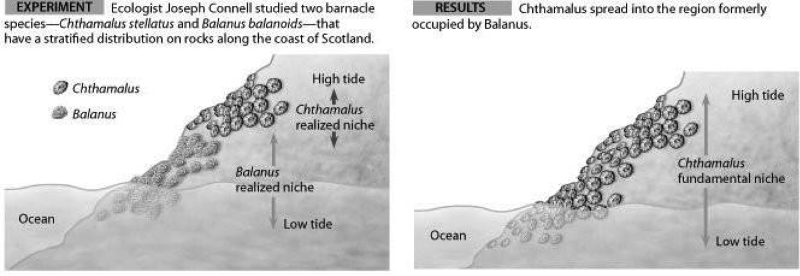
Use the figures to answer the following question.
In this experiment, Balanus was removed from the habitat shown on the left. Which of the following statements is a valid conclusion of this experiment?
A) Balanus can survive only in the lower intertidal zone because it is unable to resist desiccation.
B) Balanus is inferior to Chthamalus in competing for space on rocks lower in the intertidal zone.
C) When the two species of barnacles compete with each other, both species still occupy low and high tide areas.
D) The removal of Balanus shows that competitive exclusion prevented Chthamalus from occupying the lower tide region of its fundamental niche.
Answer: D
Use the figures to answer the following question.
Connell conducted this experiment to learn more about ________.
A) character displacement in the color of barnacles
B) habitat preference in two different species of barnacles
C) how sea-level changes affect barnacle distribution
D) competitive exclusion and distribution of barnacle species
Answer: D
The symbols +, -, and 0 are used to show the results of interactions between individuals and groups of individuals. The symbol + denotes a positive interaction, - denotes a negative interaction, and 0 denotes interactions in which individuals are not affected. The first symbol refers to the first organism mentioned. What interactions exist between a lion pride and African wild dogs, if the dogs are found to typically avoid areas with lions?
A) +/+
B) +/-
C) 0/0
D) -/-
Answer: B
The symbols +, -, and 0 are used to show the results of interactions between individuals and groups of individuals. The symbol + denotes a positive interaction, - denotes a negative interaction, and 0 denotes interactions in which individuals are not affected. The first symbol refers to the first organism mentioned. Which fact is correct when describing species interactions?
A) +/0 will always remain such.
B) A +/- interaction could shift to +/0 or +/+ over time, depending on other factors such as competition, population density, or environmental changes.
C) Species interactions occur in isolation and cannot affect the structure of ecological communities.
D) A -/- interaction benefits both of the species in the relationship.
Answer: B
Which of the following statements is consistent with the principle of competitive exclusion?
A) The random distribution of one competing species will have a positive impact on the population growth of the other competing species.
B) If two species have the same fundamental niche, one will exclude the other competing species.
C) Even a slight reproductive advantage will eventually lead to the elimination of the less well adapted of two competing species.
D) Natural selection tends to increase competition between related species.
Answer: C
If two species are close competitors, and one species is experimentally removed from the community, the remaining species would be expected to ________.
A) change its fundamental niche
B) decline in abundance
C) become the target of specialized parasites
D) expand its realized niche
Answer: D
Which of the following is an example of a commensalism?
A) fungi residing in plant roots, such as endomycorrhizae
B) bacteria fixing nitrogen on the roots of some plants
C) rancher ants that protect aphids in exchange for sugar-rich honeydew
D) cattle egrets eating insects stirred up by grazing bison
Answer: D
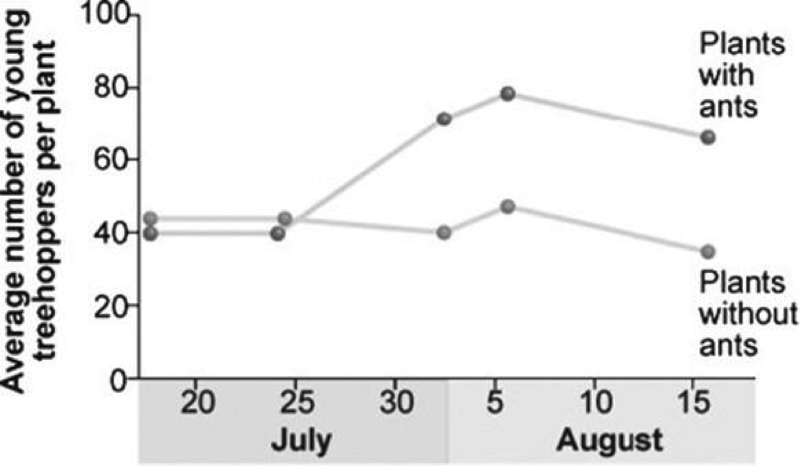
Use the figure to answer the following question.
Treehoppers (a type of insect) produce honeydew, which ants use for food. Treehoppers have a major predator, the jumping spider. Researchers hypothesized that the ants would protect the treehoppers from the spiders. In an experiment, researchers followed study plots with ants removed from the system and compared them to a control plot. From the figure, what can you conclude?
A) Ants do somehow protect the treehoppers from spiders.
B) Ants eat the honeydew produced by treehoppers.
C) Ants reduce the numbers of treehoppers.
D) No specific conclusions can be drawn from this figure.
Answer: A
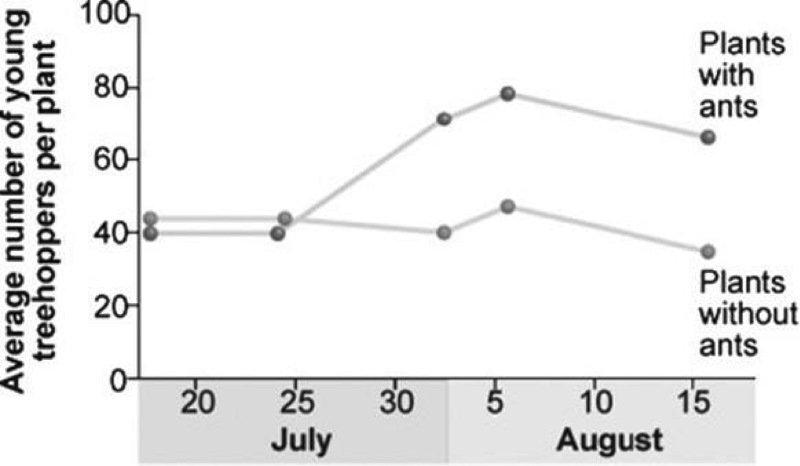
Use the figure to answer the following question.
Treehoppers (a type of insect) produce honeydew, which ants use for food. Treehoppers have a major predator, the jumping spider. Researchers hypothesized that the ants would protect the treehoppers from the spiders. During a one-year study, researchers found no difference in treehopper populations in any of their control and experimental groups. What could they measure during the second year to gain information about why this might have occurred?
A) Measure the number of ant females.
B) Measure the relative sizes of the treehoppers.
C) Measure the relative abundance of jumping spiders.
D) Measure the relative sizes of different ant species.
Answer: C
Resource partitioning would be most likely to occur between ________.
A) sympatric populations of species with similar ecological niches
B) sympatric populations of a flowering plant and its specialized insect pollinator
C) allopatric populations of the same animal species
D) allopatric populations of species with similar ecological niches
Answer: A
15) Character displacement differs from resource partitioning because character displacement ________.
A) is a fundamental difference in feeding behaviors of individuals
B) is directly linked to the evolution of genotypes that have allowed alternate resource use
C) is a difference in the niche within a habitat that is preferred to be used by a species
D) is not the result of competition
Answer: B
Which of the following is an example of Müllerian mimicry?
A) two species of unpalatable butterfly that have the same color pattern
B) a day-flying hawkmoth that looks like a wasp
C) a chameleon that changes its color to look like a dead leaf
D) one species of a non-venomous snake which rattles its tail to mimic a venomous rattlesnake
Answer: A
) Which of the following is an example of Batesian mimicry?
A) a butterfly that resembles a leaf
B) a nonvenomous larva of a moth that moves like a venomous snake
C) a fawn with fur coloring that camouflages it in the forest environment
D) a snapping turtle that uses its tongue to mimic a worm, thus attracting fish
Answer: B
Which of the following is an example of aposematic coloration?
A) a non-poisonous snake mimics the color of a poisonous one
B) the brightly colored patterns of monarch butterfly caterpillars
C) green color of a plant
D) a katydid whose wings look like a dead leaf
Answer: B
Dwarf mistletoes are flowering plants that grow on certain forest trees. They obtain nutrients and water from the vascular tissues of the trees. The trees derive no known benefits from the dwarf mistletoes, nor are they negatively affected by this interaction. Which of the following best describes the interactions between dwarf mistletoes and trees?
A) mutualism
B) commensalism
C) competition
D) facilitation
Answer: B
In some circumstances, grasses that initially lose tissues from being consumed by animals such as elk or cattle regrow more than they would have otherwise, and benefit from the moderate levels of grazing. Which of the following terms would best describe such a plant-herbivore interaction?
A) mutualism
B) commensalism
C) parasitism
D) predation
Answer: A
Which of the following measurements would be most helpful in understanding the structure of an ecological community?
I) determining how many species are present overall
II) determining which particular species are present
III) determining the kinds of interactions that occur among individuals of the same species
IV) determining the abundance of resources available for one species
A) only I and II
B) only II and IV
C) only I, II, and III
D) I, II, III, and IV
Answer: A
Which of the following studies would a community ecologist undertake to learn about competitive interactions?
I) selectivity of nest sites among cavity-nesting songbirds
II) the grass species preferred by grazing pronghorn antelope and bison
III) stomach analysis of brown trout and brook trout in streams where they coexist
A) only I and II
B) only I and III
C) only II and III
D) I, II, and III
Answer: D
How might an ecologist test whether a species is occupying all of its fundamental niche or only a portion of it?
A) Study the temperature range and humidity requirements of the species.
B) Observe if the species expands its range after the removal of a competitor.
C) Measure the change in reproductive success when the species is subjected to environmental stress.
D) Observe if the niche size changes after the introduction of a similar non-native species.
Answer: B
The symbols +, -, and 0 are to be used to show the results of interactions between individuals and groups of individuals. The symbol + denotes a positive interaction, - denotes a negative interaction, and 0 denotes where individuals are not affected by interacting. The first symbol refers to the first organism mentioned. What interactions exist between cellulose-digesting organisms in the gut of a termite and the termite?
A) +/+
B) +/0
C) +/-
D) 0/0
Answer: A
The symbols +, -, and 0 are to be used to show the results of interactions between individuals and groups of individuals. The symbol + denotes a positive interaction, - denotes a negative interaction, and 0 denotes where individuals are not affected by interacting. The first symbol refers to the first organism mentioned. What interactions exist between mycorrhizae and evergreen tree roots?
A) +/+
B) +/0
C) +/-
D) 0/0
Answer: A
Bouchard and Brooks studied the effect of insect flight on dispersal and speciation in rain forest insects. They sampled all of the insects in the study area and found that 60 insect species are flightless and 19 are able to fly. What can you conclude so far about this study? (P. Bouchard and D. R. Brooks. 2004. Effect of vagility potential on dispersal and speciation in rainforest insects. Journal of Evolutionary Biology 17:994-1006.)
A) Flightless insects have a greater dispersal potential from this study area.
B) Flightless insects are more numerous in the study area.
C) Flightless insects have a higher species richness in the study area.
D) Flightless insects are better suited for the tropics.
Answer: C
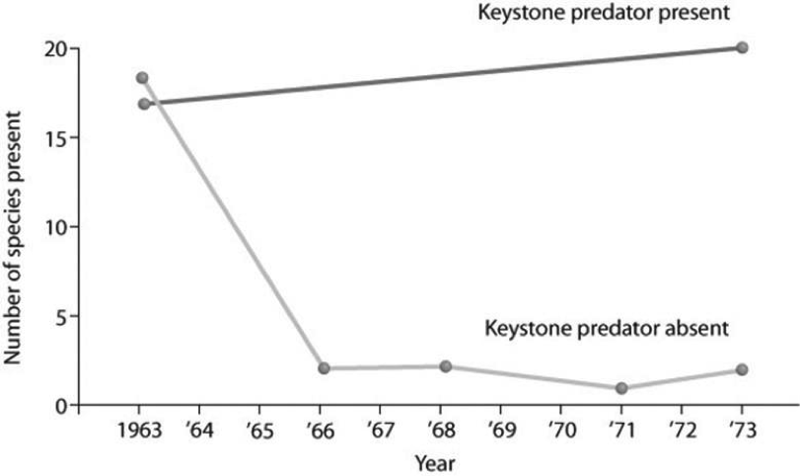
Use the graph to answer the following question.
What does the graph tell you about the effect of a keystone species?
A) A keystone species has little interaction with other species in an environment.
B) Removing a keystone species from the community drastically reduces species richness.
C) Adding a keystone species to the community will make it more diverse.
D) Removing a keystone species from the community will eventually allow for the invasion of a new species.
Answer: B
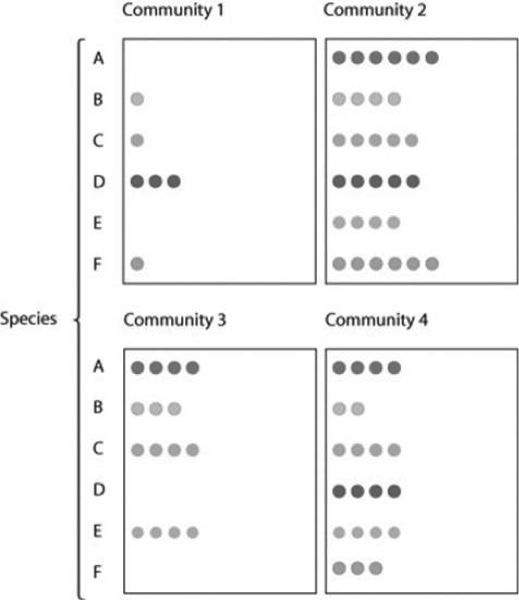
Use the figure to answer the following question.
In the figure, species A through F are found among four communities, with the number of circles representing their abundance. Which community has the highest species richness but does not have the highest diversity overall because of the relative abundance of the different species?
A) Community 1
B) Community 2
C) Community 1 and community 3 have the highest species diversity.
D) Community 4
Answer: D
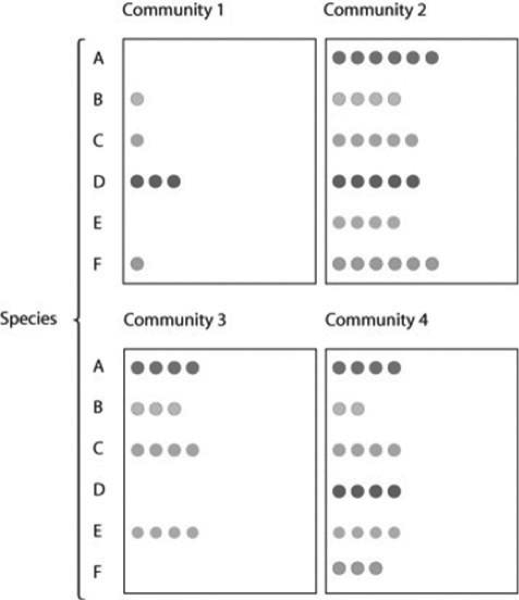
Use the figure to answer the following question.
In the figure, imagine that community 4 represents a marine community off the coast of Florida, where overfishing of a particular trophy fish (imagine a species G) for two decades gradually shifted it to resemble community 3. The species that was overfished was likely ________.
A) an invasive species
B) a keystone species
C) a primary producer
D) species A, B, C, E, and F
Answer: B
Approximately how many kilograms (kg) of carnivore (secondary consumer) biomass can be supported by a field plot containing 1000 kg of plant material?
A) 1000
B) 100
C) 10
D) 1
Answer: C
Elephants are not the most abundant species in African grasslands, yet they influence community structure. The grasslands contain scattered woody plants, but they are kept in check by the uprooting activities of the elephants. Take away the elephants, and the grasslands are converted to forests or to shrublands. The newly growing forests support fewer species than the previous grasslands. Which of the following statements describes why elephants are the keystone species in this scenario?
A) Elephants exhibit a disproportionate influence on the structure of the community relative to their abundance.
B) Grazing animals depend upon the elephants to convert forests to grassland.
C) Elephants are the biggest herbivore in this community.
D) Elephants help other populations survive by keeping out many of the large African predators.
Answer: A
According to bottom-up and top-down control models of community organization, which of the following expressions would imply that an increase in the size of a carnivore (C) population would negatively impact its prey (P) population, but not vice versa? The arrows between species indicate a negative impact toward the population at the arrowhead.
A) P ← C
B) P → C
C) C ↔ P
D) P ← C → P
Answer: A
Which of the following statements is a likely explanation for why invasive species take over communities into which they have been introduced?
A) Invasive species are less efficient than native species in competing for the limited resources of the environment.
B) Invasive species are not held in check by the predators and agents of disease that have always been in place for native species.
C) Invasive species have a higher reproductive potential than native species.
D) Invasive species come from geographically isolated regions, so when they are introduced to regions where there is more competition, they thrive.
Answer: B
Imagine five forest communities, each with one hundred individuals distributed among four different tree species (W, X, Y, and Z). Which forest community would be most diverse?
A) 25W, 25X, 25Y, 25Z
B) 40W, 30X, 20Y, 10Z
C) 50W, 25X, 15Y, 10Z
D) 70W, 10X, 10Y, 10Z
Answer: A

Use the figures to answer the following question.
According to the Shannon Diversity Index, which of the five blocks above, with each containing 36 squares, would show the greatest diversity? The different shades represent different species, and more squares of a shade represent higher abundance.
A) 1
B) 2
C) 4
D) 5
Answer: D
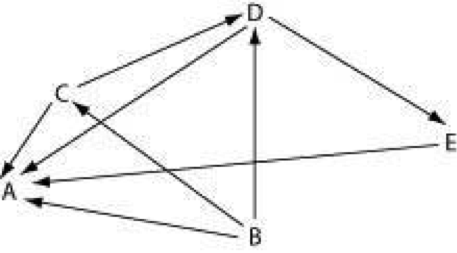
Use the following diagram of a hypothetical food web to answer the question. The arrows represent the transfer of energy between the various trophic levels.
Which letter represents an organism that could be a producer?
A) A
B) B
C) D
D) E
Answer: B
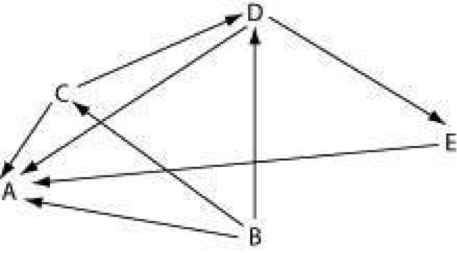
Use the following diagram of a hypothetical food web to answer the question. The arrows represent the transfer of energy between the various trophic levels.
Which letter represents an organism that could only be a primary consumer?
A) A
B) B
C) C
D) D
Answer: C
Keystone predators can maintain species diversity in a community if they ________.
A) competitively exclude other predators
B) prey on the community's dominant species
C) allow immigration of other predators
D) prey only on the least abundant species in the community
Answer: B
Food chains are sometimes short because ________.
A) only a single species of herbivore feeds on each plant species
B) local extinction of a species causes extinction of the other species in its food chain
C) most of the energy in a trophic level is lost as it passes to the next higher level
D) predator species tend to be less diverse and less abundant than prey species
Answer: C
Which of the following could qualify as a top-down control on a grassland community?
A) limitation of plant biomass by rainfall amount
B) influence of temperature on competition among plants
C) influence of soil nutrients on the abundance of grasses versus wildflowers
D) effect of grazing intensity by bison on plant species diversity
Answer: D
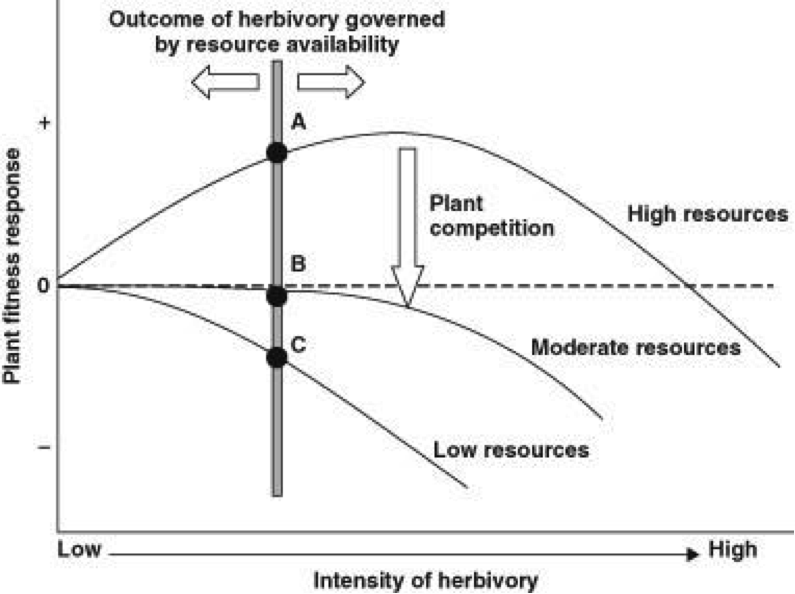
Use the figure to answer the following question.
The figure proposes a combination of a top-down and bottom-up model (a hypothesis) to describe the variable effects of biological control herbivores on the fitness (growth and reproduction) of an invasive, non-native plant, spotted knapweed (Centaurea stoebe). These herbivores include multiple insects that were first studied in the plant's native home range in eastern Europe, where the plant is not dominant in grassland communities and does not pose a problem to land managers and conservationists. Many insects there were found to consume the plant's tissues, including stems, leaves, and seeds, and some were very host specific and were not found to attack plants other than C. stoebe. Several insects were subsequently transported and released in an attempt to reduce densities of this non-native and problematic weed in the United States. The y-axis shows C. stoebe plant fitness, and the x-axis represents the intensity of herbivory by the insects, from low to high. As the vertical shaded bar is moved along the x-axis, the ultimate effect of herbivory (now A, B, and C) on plant fitness can change based on its intensity and also may depend on the other factors. The horizontal dashed line represents no predicted change in fitness under the effects of varying intensity of herbivory, plant competition, and soil resources available to the plant (such as nitrogen or water), while the three solid lines represent other possible outcomes.
(D.G. Knochel and T.R. Seastedt. 2011. Reconciling contradictory findings of herbivore impacts on spotted knapweed (Centaurea stoebe) growth and reproduction. Ecological Applications 20(7):1903-1912. What portion of the model would be characterized as bottom-up?
A) plant fitness
B) resources available to the plant
C) intensity of herbivory on the plant
D) plant competition and fitness
Answer: B
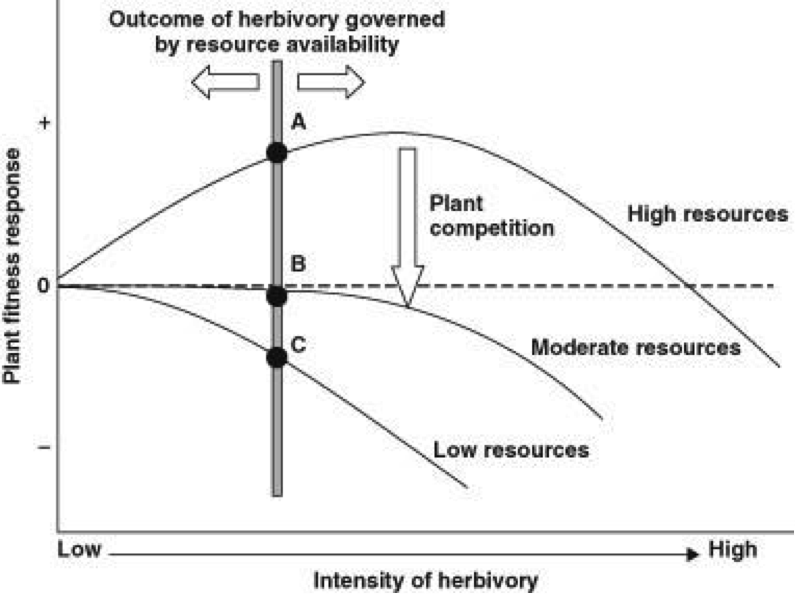
Use the figure to answer the following question.
The figure proposes a combination of a top-down and bottom-up model (a hypothesis) to describe the variable effects of biological control herbivores on the fitness (growth and reproduction) of an invasive, non-native plant, spotted knapweed (Centaurea stoebe). These herbivores include multiple insects that were first studied in the plant's native home range in eastern Europe, where the plant is not dominant in grassland communities and does not pose a problem to land managers and conservationists. Many insects there were found to consume the plant's tissues, including stems, leaves, and seeds, and some were very host specific and were not found to attack plants other than C. stoebe. Several insects were subsequently transported and released in an attempt to reduce densities of this non-native and problematic weed in the United States. The y-axis shows C. stoebe plant fitness, and the x-axis represents the intensity of herbivory by the insects, from low to high. As the vertical shaded bar is moved along the x-axis, the ultimate effect of herbivory (now A, B, and C) on plant fitness can change based on its intensity and also may depend on the other factors. The horizontal dashed line represents no predicted change in fitness under the effects of varying intensity of herbivory, plant competition, and soil resources available to the plant (such as nitrogen or water), while the three solid lines represent other possible outcomes.
(D.G. Knochel and T.R. Seastedt. 2011. Reconciling contradictory findings of herbivore impacts on spotted knapweed (Centaurea stoebe) growth and reproduction. Ecological Applications 20(7):1903-1912. What is the model's prediction for C. stoebe plant fitness when growing under high soil resource conditions?
A) Plant fitness decreases as a result of low intensity herbivory.
B) Plant fitness increases under all levels of intensity of herbivory.
C) Plant fitness decreases only if the intensity of herbivory is very high.
D) Plant fitness does not change.
Answer: C
Recall that Clements's view of biological communities is that of a highly predictable and interrelated structure, while Gleason's view of biological communities is that individual species operate independently. If we set up many identical sterilized ponds in the same area and allowed them to be colonized, what result should we expect Gleason had a more accurate view of communities than did Clement's hypothesis?
A) Identical plankton communities will develop in all ponds.
B) Similar plankton communities will develop in all ponds.
C) Different plankton communities will develop in all ponds.
D) Limited plankton communities will develop in all ponds.
Answer: C
According to the nonequilibrium model of community diversity, ________.
A) community structure remains stable in the absence of interspecific competition
B) communities are assemblages of closely linked species that are permanently changed by disturbance
C) interspecific interactions induce changes in community composition over time
D) communities are constantly changing after being influenced by disturbances
Answer: D
Why do moderate levels of disturbance result in an increase in community diversity?
A) Habitats are opened up for less competitive species.
B) Competitively dominant species infrequently exclude less competitive species after a moderate disturbance.
C) The resulting uniform habitat supports stability, which in turn supports diversity.
D) Less-competitive species evolve strategies to compete with dominant species.
Answer: A
Based on the intermediate disturbance hypothesis, a community's species diversity is increased by ________.
A) frequent immigrations of new species
B) stable conditions with no disturbance
C) moderate levels of disturbance
D) intensive disturbance by humans
Answer: C
In a particular case of secondary succession, three species of wild grass all invaded a field. By the second season, a single species dominated the field and the other two species had a lower relative abundance. A possible factor contributing to the abundances of these species in this example of secondary succession is ________. A) equilibrium
B) immigration
C) inhibition
D) parasitism
Answer: C
There are more species in tropical areas than in places more distant from the equator. This is probably a result of ________.
A) fewer predators and parasites
B) more dispersed annual solar radiation compared to the poles
C) more frequent ecological disturbances over a longer time span
D) a longer time frame without disturbances for evolution and speciation
Answer: D
Which of the following is a widely supported explanation for the tendency of tropical communities to have greater species diversity than temperate or polar communities?
A) There are fewer parasites to negatively affect the health of tropical communities.
B) Tropical communities are low in altitude, whereas temperate and polar communities are high in altitude.
C) Tropical communities have higher sunlight and precipitation, and are generally older than temperate or polar communities.
D) More competitive dominant species have evolved in temperate and polar communities.
Answer: C
Which of the following is a correct statement about MacArthur and Wilson's island equilibrium model?
A) As the number of species on an island increases, the emigration rate decreases.
B) Competitive exclusion is less likely on an island that has large numbers of species.
C) Small islands receive few new immigrant species.
D) Islands closer to the mainland have higher extinction rates.
Answer: C
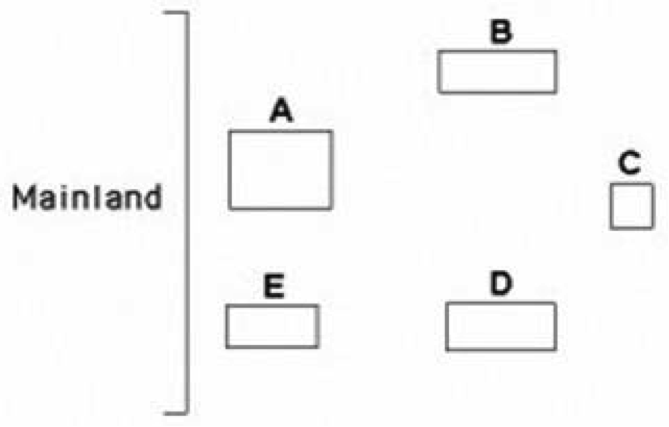
Use the following diagram of five islands formed at around the same time near a particular mainland, as well as MacArthur and Wilson's island equilibrium model principles to answer the question.
Which region would likely have the greatest species diversity?
A) island A
B) island C
C) island D
D) the mainland
Answer: D
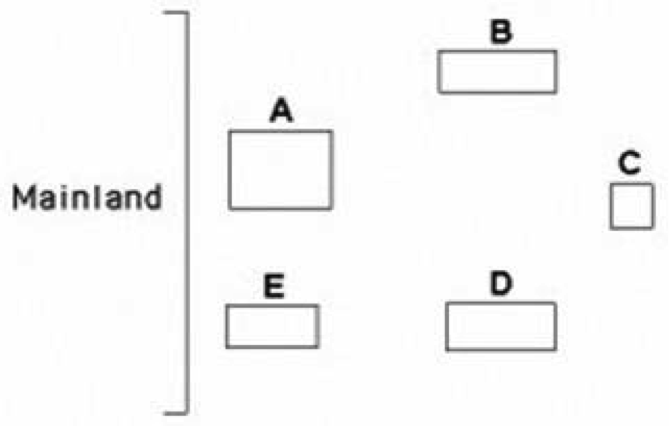
Use the following diagram of five islands formed at around the same time near a particular mainland, as well as MacArthur and Wilson's island equilibrium model principles to answer the question.
Imagine these are tropical islands. Which island would likely encounter the highest rate of species extinction if these islands were subject to unregulated, commercial logging in the rainforest?
A) A
B) B
C) C
D) E
Answer: C
Use the following diagram of five islands formed at around the same time near a particular mainland, as well as MacArthur and Wilson's island equilibrium model principles to answer the question.
Which island would likely have the lowest extinction rate?
A) A
B) C
C) D
D) E
Answer: A
According to the island equilibrium model, species richness would be lowest on an island that is ________.
A) large and close to a mainland
B) large and remote
C) small and remote
D) small and close to a mainland
Answer: C
One plausible hypothesis to explain why species richness is higher in tropical than in temperate regions is that ________.
A) tropical communities are younger
B) tropical regions generally have more available water and higher levels of solar radiation
C) higher temperatures cause more rapid speciation
D) tropical regions have very high rates of immigration and very low rates of extinction
Answer: B
Zoonotic disease ________.
A) is caused by suborganismal pathogens such as viruses, viroids, and prions only
B) is caused by pathogens that are transferred from other animals to humans by direct contact or by means of a vector
C) can only be spread from animals to humans through direct contact
D) can only be transferred from animals to humans by means of an intermediate host
Answer: B
Why is a pathogen generally more virulent in a new habitat?
A) Intermediate host species are more motile and transport pathogens to new areas.
B) Pathogens evolve more efficient forms of reproduction in new environments.
C) Hosts in new environments have not had a chance to become resistant to the pathogen through natural selection.
D) New environments are almost always smaller in area so that transmission of pathogens is easily accomplished between hosts.
Answer: C
Which of the following best describes the consequences of white-band disease in Caribbean coral reefs?
A) Staghorn coral is decimated by the pathogen, and Elkhorn coral takes its place.
B) Key habitat for lobsters, snappers, and other reef fishes improves.
C) Algal species take the place of the dead coral, and the fish community is dominated by herbivores.
D) Algal species take over and the overall reef diversity increases due to increases in primary productivity.
Answer: C
Which of the following studies would shed light on the mechanism of spread of H5N1 virus from Asia to North America?
A) Perform cloacal or saliva smears of migrating waterfowl to monitor whether any infected birds show up in Alaska.
B) Test fecal samples for H5N1 in Asian waterfowl that live near domestic poultry farms in Asia.
C) Test for the presence of H5N1 in poultry used for human consumption worldwide.
D) Locate and destroy birds infected with H5N1 in Asian open-air poultry markets.
Answer: A
In terms of community ecology, why are pathogens often more virulent now than in the past?
A) More new pathogens have recently evolved.
B) Host organisms have become more susceptible because of weakened immune systems.
C) Human activities are transporting pathogens into new habitats (or communities) at an unprecedented rate.
D) Medicines for treating pathogenic disease are in short supply.
Answer: C
The oak tree fungal pathogen, Phytophthora ramorum, has migrated 800 kilometers in 15 years. West Nile virus spread from New York State to 46 other states in 5 years. The difference in the rate of spread is probably related to ________.
A) the lethality of each pathogen
B) the mobility of their hosts
C) the fact that viruses are very small
D) innate resistance
Answer: B
Scientists interested in how populations interact within communities are attempting to determine the species diversity of an island under study. What kind of data would be most helpful to the scientists in determining diversity?
A) the number of different species on the island and the size of the population of each species
B) the number of species on the island that are consumers, producers, and decomposers
C) the relative biomass of each species on the island separated by trophic level
D) the number of trophic levels on the island and the niche of each species
Answer: A
Red-cheeked salamanders are partially protected from predators because of cardiac glycosides they produce from glands on their back. When ingested, cardiac glycosides disrupt normal heart rhythms. A different salamander species, the imitator salamander, also has red cheek patches, but does not produce cardiac glycosides. It does gain protection from predators that have learned to avoid red-cheeked salamanders. How does this relationship affect the population dynamics of both species?
A) Both species are negatively affected.
B) Both species are positively affected.
C) The red-cheeked salamander is positively affected; the imitator is negatively affected.
D) The red-cheeked salamander is not affected; the imitator is positively affected.
Answer: D
The feeding relationships among the species in a community determine the community's
A) secondary succession.
B) ecological niche.
C) species richness.
D) trophic structure.
Answer: D
The principle of competitive exclusion states that
A) two species cannot coexist in the same habitat.
B) competition between two species always causes extinction or emigration of one species.
C) two species that have exactly the same niche cannot coexist in a community.
D) two species will stop reproducing until one species leaves the habitat.
Answer: C
Based on the intermediate disturbance hypothesis, a community's species diversity is increased by
A) frequent massive disturbance.
B) stable conditions with no disturbance.
C) moderate levels of disturbance.
D) human intervention to eliminate disturbance.
Answer: C
According to the island equilibrium model, species richness would be greatest on an island that is
A) large and remote.
B) small and remote.
C) large and close to a mainland.
D) small and close to a mainland.
Answer: C
Predators that are keystone species can maintain species diversity in a community if they
A) competitively exclude other predators.
B) prey on the community's dominant species.
C) reduce the number of disruptions in the community.
D) prey only on the least abundant species in the community.
Answer: B
Food chains are sometimes short because
A) only a single species of herbivore feeds on each plant species.
B) local extinction of a species causes extinction of the other species in its food chain.
C) most of the energy in a trophic level is lost as energy passes to the next higher level.
D) most producers are inedible.
Answer: C
Which of the following could qualify as a top-down control on a grassland community?
A) limitation of plant biomass by rainfall amount
B) influence of temperature on competition among plants
C) influence of soil nutrients on the abundance of grasses versus wildflowers
D) effect of grazing intensity by bison on plant species diversity
Answer: D
The most plausible hypothesis to explain why species richness is higher in tropical than in temperate regions is that
A) tropical communities are younger.
B) tropical regions generally have more available water and higher levels of solar radiation.
C) higher temperatures cause more rapid speciation.
D) diversity increases as evapotranspiration decreases.
Answer: B